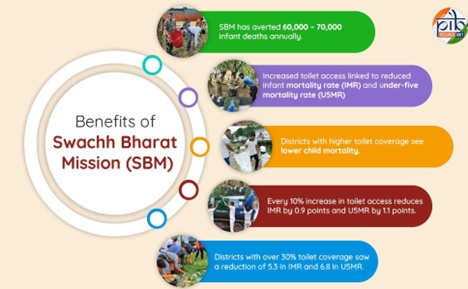TAG: GS-2 GOVERNANCE
THE CONTEXT: Swachh Bharat Mission (SBM) which was launched by the Indian Prime Minister in 2014 will complete 10 years on 2 oct 2024.
EXPLANATION:
About the Swachh Bharat Mission (SBM):
- The Prime Minister launched the Swachh Bharat Mission on 2nd October 2014 to achieve universal sanitation coverage and make India “open-defecation free”.
- The initiative intends to enhance the health and well-being of millions of Indians by building over 100 million toilets in rural regions, creating a global standard for community-driven sanitation reform.
- In rural areas, “SBM – Gramin” is funded and monitored by the Ministry of Jal Shakti (earlier Ministry of Drinking Water and Sanitation).
- “SBM – Urban” is overseen by the Ministry of Housing and Urban Affairs.
- The government provided subsidies for the construction of toilets.

The campaign is handled by two ministries:
- Ministry of Drinking Water and Sanitation: Responsible for SBM-Gramin (rural areas).
- Ministry of Housing and Urban Affairs: Handles SBM-Urban (urban areas).
| Swachh Bharat Mission – Grameen: Phase I (2014–2019) | Swachh Bharat Mission – Grameen: Phase II (2019–2025) |
|
|
10-Year Analysis of Swachh Bharat Mission:
Significance:
- More than 100 million toilets were constructed to provide access to sanitation for millions of rural households.
- The ODF status improved hygiene and public health, particularly in underserved areas.
- Studies have linked SBM to a significant reduction in infant mortality and under-five mortality rates by improving hygiene and reducing exposure to diseases like diarrhoea and malnutrition.
- The campaign also emphasised behavioural change through Information, Education, and Communication (IEC) efforts, leading to a lasting shift in sanitation practices across India.
- The construction of household toilets in rural areas, enhanced women’s dignity and safety, reducing the need for them to travel far for defecation.
- In Phase II (2019-2025), the mission expanded to address waste management.
- The SBM has become a global model of community-driven sanitation reform, highlighting how large-scale improvements can be achieved quickly through collective action and government initiative.
Challenges:
- The mission aims to get ODF status, but sustaining this status remains a challenge.
- The transition from ODF to ODF Plus is complex, with many rural and urban areas lacking adequate waste treatment infrastructure, leading to improper disposal and environmental concerns.
- Water scarcity in some areas makes it difficult to maintain toilets and sanitation facilities, resulting in a decline in toilet usage.
- Sanitation worker welfare is also a concern, with harsh working conditions often overlooked.
- The urban-rural divide remains a challenge, particularly in slums and informal settlements.
- Behavioural challenges have limitations, with some communities resisting toilet use, especially in regions where open defecation is the traditional practice.
- Ensuring proper safety measures, fair wages, and better working conditions is essential for the long-term sustainability of the mission.
Source:
Spread the Word
